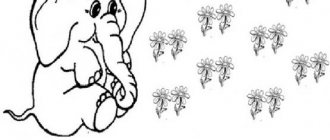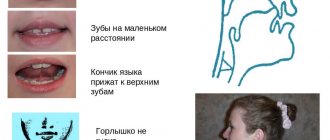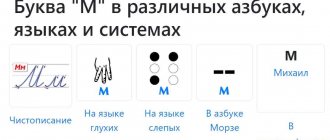Study Materials
Poetry
* * * The letter “X” laughed: “Even though it’s cold in winter, I’m not tired of sledding, going down the icy hill.”
Poems about the letter "X"
Puzzles
* * * The hamster slammed the grain into his backpack, and hurried to the hut, so that no one would make him laugh. Let's tickle the hamster, let him tell us the letter...
Riddles about the letter "X"
Tongue Twisters
* * * The letter X bought a stove to bake firewood for us. She brought brushwood from the forest and baked crispy brushwood.
Tongue twisters starting with the letter "X"
Fairy tales
Making the sound “X” when replacing it with “T”.
Staging sounds.
Rear lingual:
Making the sound “X” when replacing it with “T”.
Pay attention to the fact that the sounds are different in the place of formation and in the method. The sound “T” is plosive, labial-dental, and the sound “X” is fricative, posterior lingual. Play with these features: perform the production slowly from the combination “HK”. Or ask the child to round his lips, then place the tip of his tongue behind the lower incisors, make the tongue “slide” and let the wind blow. From the book by V.M. Akimenko “Correction of sound pronunciation in children”
Making the sound "K" from "T".
Using a frame probe or spatula, start from the syllable “ta”. Moving the tip of the tongue with a probe inside the mouth, we hear “kya” at the beginning, then “ka”.
Making the sound “K” while inhaling.
1. While inhaling, the child should “suck” the tongue as far into the throat as possible, “like a snail into a shell.” Show him how to do this, while inhaling you should pronounce syllables that are close in sound to the sound combination [ka - ka - ka]. 2. This can also be compared to a silent (whispering) imitation of snoring, just make sure that in your pronunciation there is no rolling throat sound reminiscent of the grating sound [r] (after [k] you can hear a short aspirated sound reminiscent of [x]). You can pronounce a sound that is as close as possible to the sound [k]. 3. In the future, let the child pronounce the syllable [ka] first while inhaling and then exhaling (“sucked in the snail - now let it out” or “snorled in - now out”). In order to avoid the appearance of a booming pronunciation, the syllables must be pronounced very quietly, in a whisper (so as not to wake up someone sleeping nearby with your snoring). 4. When the child pronounces the syllable [ka] freely as he exhales, tell him what sound he is making and let him repeat it after you in isolation. 5. Then train the pronunciation of the sound [k] in syllables with other vowels and only on exhalation. The child should repeat the syllables after you.
The material is taken from the book by M. Polyakova “Self-instruction manual on speech therapy. Universal benefit"
Making the sound “K” from the correct “X”. 1. Draw the child’s attention to the fact that when he carefully pronounces the sound [x], the root of his tongue touches the palate; let him feel this place with his tongue. It is necessary that during a long, drawn-out pronunciation of the sound [x], the child, in the place where he feels the touch of the tongue on the palate, clamps the gap with it and blocks the flow of air, as if “putting a point there” with the tongue. 2. Under the formed bow, the air stream will be under some pressure. At this moment, the child, coughing slightly, should exhale it from his mouth into his palm, as a result the sound [k] will be heard. 3. In the future, the child should immediately press the root of the tongue against the gap in the throat and pronounce the sound [k]. If the sound turns out to be too “explosive” or intense, and also if it has an aspirated tone, you need to practice whispering its pronunciation (in a whisper - “cough” barely audible, almost without exhaling, eliminating the middle overtone [x] from your pronunciation). The child should repeat up to you (this should be done after a full exhalation). 4. After the child produces a sound freely, tell him what sound he has learned to pronounce. 5. Then proceed to pronunciation of syllables (by imitation).
Making the sound “K” by imitation.
1. The child should “cough” after you. Open your mouth wide so that the child can see how your tongue is positioned, and, exhaling air, imitate a slight cough (the kind that happens when the throat is sore), with a noticeable sound [k] ([cough]). You need to “cough” quietly with minimal exhalation, then between the sounds [k] and [e] there will be no pronounced sound [x], but only a slight aspiration will be heard. Repeating the exercise after you, the child should “cough” into his palm. 2. Using your thumb and forefinger, you can slightly squeeze his neck in the throat area just under the chin. This will make the [k] sound when “coughing” more distinct. 3. After this, show your child how to “cough” in a whisper - “cough” barely audibly, almost without exhaling, eliminating the middle sound [x] from your pronunciation. The child should repeat after you. This should be done after a complete exhalation. 4. If the correct sound [k] is obtained, that is, the child actually pronounces the syllable [ke], after practicing it, move on to syllables with other vowel sounds. You can give the following instructions: “Now we will cough like this: [ka - ka - ka]” 5. At the end, pronounce the sound in isolation, let the child repeat it after you.
Making the sound “X” from the correct soft “H.”
To distract your child's attention, tell him that you are learning to “laugh” with him. 1. Following you, the child should “giggle”, carefully and exaggeratedly pronouncing the syllables [hee - hee - hee]. It must be pronounced quietly and abruptly, otherwise the emphasis will be on the vowel sound and the characteristic sound of the consonant will be partially lost. The child should feel the air stream “squealing” in his throat. You can put your palm to your mouth to feel the exhalation on it. 2 . Next, pronouncing these syllables, you need to open your mouth wider, about the width of a finger. In this position, the child should “giggle” after you as follows: [hee - ha - hee - ha] (since the mouth is slightly open, instead of [hee] almost [hee] will come out). If in the syllable [ha] a full-fledged hard sound [x] is heard, move on to syllables with vowels [e, o, y, y]. Everything is done by imitation. 3. If the sound [x] remains somewhat soft (the syllable [ha] will sound close to [x'ya]), you need to pronounce the syllables [hi - hi - ha - ha - ha] as follows. When pronouncing the syllables [ha - ha - ha], the child should gradually open his mouth wider and wider until the full sound [x] is heard. Syllables with the sound [x'] must be pronounced, exaggerating the characteristic sound of this sound as much as possible. The child performs the exercise after you. Remind him to keep his tongue at the place in his throat where he makes his “giggle” sound. 4. Syllables with other vowels should also be pronounced by opening your mouth wider. 5. At the end, say the sound in isolation, let the child repeat it after you.
The material is taken from the book by M. Polyakova “Self-instruction manual on speech therapy. Universal benefit"
Making the sound "X" from the correct "K".
You only give the child instructions without using your own pronunciation. 1. Let the child, without lifting his tongue from the palate, pronounce the sound [k] for a long time and clearly. The result is the sound combination [kh – x – x]. Point out to your child that after [k] another sound is heard, exactly the one you need. Let the child put his hand to his mouth and “blow” into it with the next sound after [k]. 2. Next you need to pronounce the sound combination (actually the syllable [kh – x – ha] (using the appropriate picture), in the middle there should be a long-sounding [x], the sound [a] at the end should be pronounced briefly and abruptly - this will give the sound [x] greater intelligibility. 3. Then the child should pronounce the syllables [kh - x - ha - ha - ha] (tell him to repeat only the second sound after [k] 4. Tell the child what sound he is pronouncing. 5. In the future, he should pronounce syllables [ha - ha - ha] and syllables with other vowel sounds. This can be done by imitation
Making the sound “X” by imitation.
The method is to imitate laughter.
You need to laugh after exhaling (shoulders down), quietly, in a low voice.
For control, use your palm to feel the “laughs” - shocks of hot air.
In the future, the child is invited to laugh, pronouncing HO-HO-HO, HE-HE-HE, HY-HY-HY and soft HI, HE, HYO.
Making the sound "G".
Using a frame probe or spatula, from the syllable “YES”, moving the tip of the tongue with the probe inside the mouth, at the beginning you hear “GY”, and then “GA”.
Setting the sound "K". The “K” sound should be placed mechanically using a finger or spatula, based on the “T” sound. In this case, the sound “T” should be “pure” for the child, that is, pronounced without overtones. The child is asked to pronounce the syllable “TA”. At the moment of pronunciation, the teacher presses his finger on the front part of the back of the tongue, resulting in the syllable “TYA”. Then the teacher moves the finger a little deeper, resulting in the syllable “KY”.
Finally, the third stage - even deeper pressure on the tongue - produces a hard sound - “KA”. Quite often there are such cases: as soon as the teacher brings his finger closer to the child’s mouth, the child immediately moves his tongue into the back of his mouth - hides his tongue from the teacher. In such cases, the teacher must accustom the child to the finger. To do this, he asks the child to pronounce the syllable “TA”, and he just puts his finger on the tip of his tongue without pressing it. The child should be trained in this way until he learns not to push the tip of his tongue back in this position. Then the teacher begins the work described above on setting the sound “K”. At first, the teacher uses only his finger for production, but as soon as the sound “K” is obtained correctly with his help, he teaches the child to use his own finger. The mechanical effect on the tongue should not be stopped too early, otherwise various defects in the pronunciation of k can easily take root, for example, a soft sound or the sound “K” with a guttural connotation.
Disadvantages of pronunciation of the sound “K”. 1. Instead of “K,” you hear simply a short exhalation or a cough-like sound caused by the closure of the vocal cords followed by an explosion of the bow. The language does not participate in articulation. Correction: reinstall the sound.
2. “K” is replaced by the sound “X”. Reason: the tongue does not press tightly against the palate, leaving a gap through which air passes noisily. Correction: a) enable the child to feel the difference on the back of the hand between a sharp push of air with “K” and a smooth stream with “X”; b) if this does not help, reinstall it mechanically. 3. Instead of the hard “K”, a soft (“ket” place “cat”) is heard. Reason: the tongue does not close with the back, but with the middle part of the palate. This articulation is correct for "KE", "KI", where the sound of "K" is softened by the influence of the following vowels. Correction: Show in front of a mirror that the tongue should be pulled back. Using a spatula, finger or probe, press on the back of the tongue and push the tongue back as far as necessary to obtain a solid “K”. Show the child how deep he should insert his finger into his mouth (two phalanges). 4. A deep, guttural “K” is heard, characteristic of some eastern languages. Reason: the tongue closes with its root part to the lower edge of the soft palate and to the back wall of the pharynx. The deficiency is permanent and usually occurs because the teacher or the child himself presses too deeply on the back of the tongue when making a sound. Correction: start the sound again, starting from the syllable “TA” and pressing the tongue slightly less deeply than required for a hard “K” (so that the child does not again fall into the throaty pronunciation of the sound). 5. After the sound “K” in the reverse syllable and in combination with other consonants, the overtone “E” (“Y”) is heard. Usually this deficiency corresponds to a similar defect in the pronunciation of the sounds “P” and “T”. Correction: a) check the pronunciation of the sounds “P” and “T”, if it suffers from a similar defect, first of all correct these sounds; b) eliminate the lack of pronunciation of the sound k by comparing it with the sound “P” or “T” (“ap-ak, at-ak”). Place the child’s hand on the larynx and show that after pronouncing the sound “K” it should not vibrate. Temporarily exaggerate the force of exhalation after the explosion, allowing it to be felt on the back of the hand (or on a strip of paper brought to the mouth). 6. Instead of “K” you get “G”. Reason: vocal cords are included in the work. Typically, such voicing of the sound “K” corresponds to a similar defect in the pronunciation of the sounds “P” and “T”. Correction: a) check the pronunciation of the sounds “P” and “T”, if they are voiced, first of all correct these sounds; b) eliminate the voicing of k by comparing it with the sounds “P” and “T” (pa-ka, ta-ka, apa-aka, ap-ak). Draw the child’s attention to the fact that at the moment of bowing and explosion, the larynx should not vibrate (put your hand to the larynx). Temporarily exaggerate the force of exhalation after the explosion. 7. The pronunciation of “K”, especially in the reverse syllable, resembles the sound heard when uncorking a bottle. Reason: is that, as with a similar lack of pronunciation of the sounds “P” and “T”, simultaneously with the closure of the tongue and palate, the vocal cords also close (without vibration). The explosion is produced by the air in the mouth and pharynx. Correction: a) check the pronunciation of the sounds “P” and “T” and correct it (if necessary); b) compare the pronunciation of all three sounds (p - t - k; ap - at - ak). To avoid a return to defective pronunciation, the child should be required for some time to pronounce the sound k with some aspiration. Exercises
Setting the sound "Sya".
Classes contribute to the development of fine motor skills, phonemic hearing, articulatory motor skills, and help the child quickly learn speech sounds. Classes are conducted in a playful way. It provides brief material that can be used to automate sounds.
With this sound, the teeth are exposed in a “smile”, closer together than with “C”, and the tongue no longer rests on the upper part of the lower front teeth, but slightly lower, almost on the lower gum (in the necks of the teeth). The tongue is tense. The air stream is directed at the front teeth.
We depict “chicks in the nest” with our hands. Cover all the fingers of your right hand with your left palm and move them like little birds in a nest. The chicks are sitting in the nest and shouting cheerfully to their mother: “Ti-Ti-Tisss”
When a child imitates the “chicks,” you need to make sure that the child clearly exposes all his teeth (both upper and lower). The tip of the tongue rests on the necks of the lower teeth, the air stream clearly goes in the middle to the front teeth. Blow on the back of your hand. Let him try to do it himself. If it doesn’t work, then try with “IS”, as well as with a match, pressing the tip of your tongue to the lower gums. “S” sounds thinner than “S”. Differentiate the sounds “S” and “S” more often, depicting either the mother bird - “SSSS”, or the chicks - “Sssss”, while performing figures. This contributes to the development of phonemic hearing.
If a child can pronounce the sound “Sy” for a long time, then he has mastered it and can move on to consolidating it: First, we work with words. Words with syllables are taken: everything, sve, svi, ate, slya, smi, smya, snya, sleep, sti, etc.
We learn proverbs, tongue twisters, riddles, poems.
We read a story to the child, he answers questions and retells it.
At the end, you can differentiate words with the sounds “S” and “S”: fox-foxes, gander-goslings, kerchief-pigtails, garden-sit, etc.
Sound setting (C)
From the book “Correction of violations of the pronunciation of whistling sounds in preschoolers and primary schoolchildren,” compiled by E.I. Shablyko
Goal: to achieve the correct sound of isolated sound. In the absence of sound, using the technique of imitation, they achieve the correct pronunciation of an isolated sound (s), while drawing the child’s attention to the correct position of the organs of the articulatory apparatus. The child is asked to stick his tongue between his teeth and blow on it: f-f-f, then remove the tongue behind the lower teeth, stretch his lips in a smile, clench his teeth and pronounce a sound (s): sing the song of the pump, water, breeze.
In case of labiodental sigmatism, the labial articulation must be removed. This is achieved by demonstrating the correct position of the lips when pronouncing this sound or with mechanical assistance (using a finger to move the lower lip away from the teeth). In other cases, the child is asked to smile, pull back the corners of the mouth slightly so that the teeth are visible, and blow on the tip of the tongue to produce a whistling noise typical of (C). Mechanical assistance can be used. The child pronounces the syllable TA repeatedly, the adult inserts probe No. 1 between the alveoli and the tip of the tongue (as well as the front part of the back) and lightly presses it down. A round gap is formed, passing through which the exhaled stream of air produces a whistling noise. By controlling the probe, an adult can change the size of the gap until the desired acoustic effect is obtained.
With interdental sigmatism, the child is first shown the correct articulation of sound (C). Attention is drawn to the fact that the tip of the tongue rests on the front lower teeth and should not be visible between the teeth, they are closed. If the child cannot immediately pronounce a sound by imitation, you need to resort to mechanical help: the tip of the tongue is pressed with a match. The child, having bitten it, pronounces the sound (C).
With lateral sigmatism, special preparatory work is necessary to activate the muscles of the lateral edges of the tongue, which, as a result of the exercises performed, can rise to close contact with the lateral teeth. When correcting lateral sigmatism, the child is taught to blow on the widely spread front edge of the tongue, then on the tip of the tongue between the teeth. Then the tongue is moved behind the teeth.
With nasal sigmatism, the child is asked to pronounce the sound (F) for a long time, insert the wide tip of the tongue between the lower lip and the upper incisors, then, with the wide tip of the tongue in an interdental position, blow on it with the sound (F), gradually remove the tip of the tongue behind the lower incisors.
With dental parasigmatism, the correct sound of the sound (C) is achieved using the demonstration of correct articulation, tactile sensations (with the back of the hand, the child feels a long-lasting cold air stream when pronouncing the sound (C) to an adult, and then to himself.
With hissing parasigmatism, the child is asked to pronounce the sound (F) for a long time with the wide tip of the tongue in an interdental position and achieve the correct sound (S).
At this sound, the teeth are almost closed and all are naked in a “smile.” The corners of the mouth are pulled to the sides. The tongue rests on the upper part of the lower teeth - it takes a position as with the sound “I”. In this case, a stream of air is directed to the front teeth.
Now we depict a “bird” with our hands. The palms are turned towards you, the thumbs are straightened away from you and intertwined (as if clinging to each other), the thumbs are the head, the closed fingers are the wings. Wave them. The bird flapped its wings and quietly squeaked: piss-piss-pissss.
In order for a child to imitate correctly, it is necessary to: be sure to expose all the teeth, otherwise the stream, which clearly goes to the front teeth, will be distorted and the sound will be blurry. Place your tongue exactly on the top of your lower teeth. If the tongue rests on their lower part, then the sound will be soft - “Sy”. And if the tongue roughly blocks the air flow to the front teeth, then it will go to the side or both at once. The sound will be distorted. You can try from prolonged repetition - “Isss” plus with the help of an ordinary match, which is placed on the tip of the tongue, artificially creating a channel through which air flows.
In addition to the visual and auditory analyzer, we also connect a tactile one: when we pronounce the sound “C”, we let the child feel the flow of the stream on the teeth, blowing on the back of his hand. More often ask him to depict how the bird sings at the same time as the figurine. Monitor the correct position of the lips, teeth, tongue: correct the child if necessary. With this sound, you need to get the correct air stream exactly in the middle and the position of the tongue in the upper part of the lower teeth, against which it rests.
If the sound sounds long and isolated, then it works.
We begin to consolidate it. We come up with sentences with words that contain this sound.
We come up with rhymes with syllables.
We learn rhymes with words that contain the sound “S”.
We learn proverbs, tongue twisters, riddles.
We read a story to the child, he answers questions and retells it.
Setting the sound Ш
1. If a child cannot stage traditionally from the “Cup”, I like to use the production from the sound “T” - proposed by R.I. Levina.
The mouth is wide open, the tongue is on the alveoli. Ask the child to pronounce the sound “T” with aspiration. Round your lips. After pronouncing, ask the child not to let the tongue go down, but move it to the front of the palate. The lateral edges are pressed against the molars. At first you hear TSHSHSHH. Fix the child's attention on the hissing sound - “The sound of a snake.” Then we separate the “T” from the “W”. We automate in syllables, words, sentences, etc.
2. For a long time I could not correct the back-lingual pronunciation of the sound Ш. In one book I found this technique: pronounce the syllable SA by raising the tongue upward. At first I used a probe, then the child managed it on his own.
3. Making the sound “SH” (one of the methods for personal use)
SOUND “SH” With this sound, the tip of the tongue is raised to the upper alveoli, and its edges are pressed against the molars. A small distance is maintained between the tip of the tongue and the alveoli. The lips form an oval, exposing the teeth. The distance between the teeth is approximately 2-5 mm. A warm air stream of air goes from the middle of the tongue to its tip. The voice is not involved. A hissing sound appears: sh-sh-sh. When imitating, you need to ensure that the child accurately follows the oval line with his lips, exposing his teeth, between which he maintains a distance of 2 - 5 mm (required). It is also necessary to maintain the distance between the tip of the tongue and the upper alveoli (gums), through which the exhaled air passes. If it is not there, that is, the tip of the tongue rests on the upper alveoli, then the air will flow along the edge of the tongue or along both edges. The sound will be distorted. To make the child feel the tip of the tongue lifting up, you can do the following exercises in advance: “bell” - la-la-la, “hammer” - d-d-d and “train” - ch-ch-ch. When performing the “hammer” and “train” exercises, we place a pencil with a diameter of about one centimeter on the lower teeth, and a tongue on it, and ask the child to tap the tip of the tongue on the upper alveoli. In this case, the child must blow strongly on the tip of his tongue without stopping. And then gradually slow down the “locomotive” - ch-ch and pull out the sound “Ch” longer, which should turn into “Sh”. We begin to imitate an angry goose: “shhhhhhhh”, while simultaneously performing the figure. If the child pronounces this sound correctly and clearly, then we move on to consolidating it. First, we fix the sound in syllables and in words with these syllables. We come up with sentences with words that contain the sound “III”. We teach rhymes, proverbs, riddles, rhymes with the child.
With labiodental sigmatism or if “w” = “f”
With labiodental sigmatism, it can be difficult for a child to switch from the usual pronunciation of a sound to the correct one. And if the hyoid frenulum is also short and the “cup” exercise is not possible, this method works.
We will need a wooden spatula. We ask the child to smile, stick out his tongue - pancake. We place a spatula under the tongue, lift the tongue with it and apply pressure, removing the tongue into the mouth. It turns out to be such a passive “cup”; moreover, the lips are “blocked” and do not fold into the position familiar to the child. Now we ask you to blow hard with your mouth. The result is a sound close to Sh.
Making the sound “Zh” (one of the methods for personal use)
With this sound, the position of the lips, teeth and tongue is the same as with “Sh”. The technique for performing it is exactly the same as with the sound “Sh”, but with “Zh” the vocal folds are involved in the work. The sound is ringing. Bring the back of your hand to the child’s larynx and he will feel it. When imitating, you need to make sure that you do everything that is recommended with the sound “Ш” plus turning on your voice. We pay attention to the preliminary exercise “hammer” - d-d-d, which is performed in the same way as the “train”, only in this case we slow down the “blows” of the hammer with a long exhalation, which turn into a long sound “Zh”. We hold the tip of the tongue in the upper position, without touching the upper alveoli: an air stream passes through this gap, which rubs against the tip of the tongue and the alveoli. If the child correctly and clearly imitates the sound “F,” we move on to automating it. First, we fix it in syllables and words. We come up with sentences in which words contain the sound “F”. We learn poems, riddles, proverbs, rhymes.
Staging sounds.
Rear lingual:
Making the sound “X” when replacing it with “T”.
Pay attention to the fact that the sounds are different in the place of formation and in the method. The sound “T” is plosive, labial-dental, and the sound “X” is fricative, posterior lingual. Play with these features: perform the production slowly from the combination “HK”. Or ask the child to round his lips, then place the tip of his tongue behind the lower incisors, make the tongue “slide” and let the wind blow. From the book by V.M. Akimenko “Correction of sound pronunciation in children”








